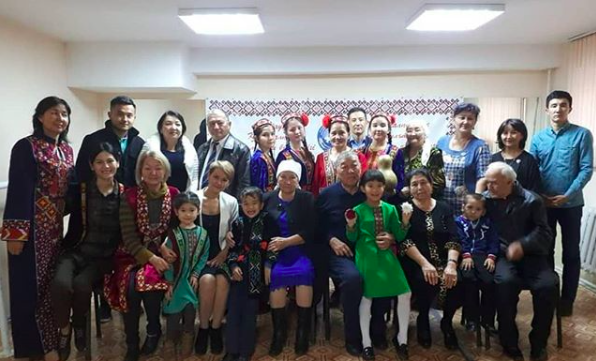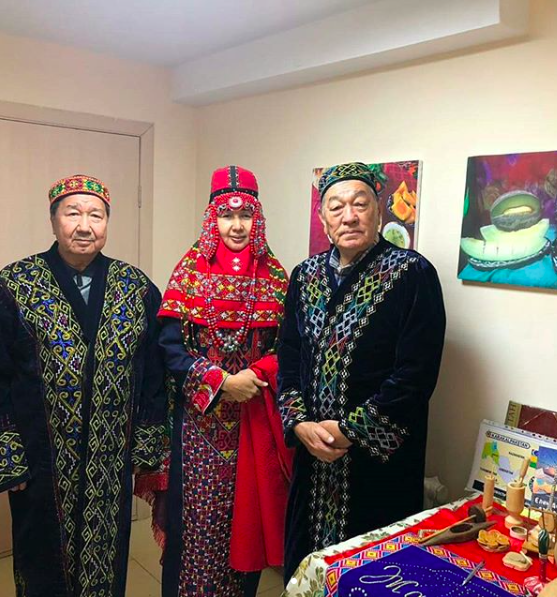Tuesday, August 25, 2020
Scythia
Friday, August 21, 2020
Big Guldursun
Saturday, July 18, 2020
Modern day Karakalpaks living in Kazakhstan
Karakalpaks’ unique culture worth celebrating and preserving in Kazakhstan, says community leader
https://astanatimes.com/2018/11/karakalpaks-unique-culture-worth-celebrating-and-preserving-in-kazakhstan-says-community-leader/
Wednesday, July 8, 2020
Jalal ad-Din Mingburnu, the last Khwarazmian Shah .

Friday, May 22, 2020
Friday, May 15, 2020
Thursday, May 7, 2020
Wednesday, May 6, 2020
Muruntau gold mine
One of the most famous
gold mines in the world is the Muruntau Mine, located in the northern part of
the Kyzylkum desert in Navoi Rayon in Central Uzbekistan. Every
year, around two million ounces of gold are mined making it currently the
highest producing gold mine in the world. The deposit was discovered in 1953,
although ancient gold mines have since been revealed in the vicinity of the ore
deposit. Detailed exploration took place between 1960 and 1965. Construction
commenced in 1964, and mining in 1967, with the gold plant beginning operation
two years later. The deposit originally contained more than 5400 tonnes
(175 Moz) of gold at an open pit recovered grade of 3.4 g/t Au.
Currently it is the
largest open-pit gold mine in the world. Its length forms about 3 500 meters,
and the width - about 2 700 meters and maximum depth of the largest
fracture is 600 meters which is planned to be extended beyond
1,000m. Even after decades of active gold mining, the mine's reserves form
more than 1,750 tons of the precious metal.
Gold mining at Muruntau is conducted using a truck and conveyor ore
transportation system. The overburden is taken to the crushing and trans hipping
points using cyclic flow technology. The ore is transported using a steeply
inclined conveyor which can handle one million tonnes of ore per year
(around 50,000 tonnes per day). Crushed ore is transported to the
hydrometallurgical plant for refining and gold production. Gold is extracted
using the heap leaching method that helps in efficient extraction of gold, even
from low-grade ores. Sorption and filter-free process is used for extracting
the gold. Also extracted is refined sliver and palladium by-product.
Source: https://www.mining-technology.com/projects/muruntau-gold-mine-uzbekistan/
Saturday, May 2, 2020
Tuesday, April 28, 2020
Karakalpak Folklaw - Alpamis
 Karakalpak folklore is rich in epics. Epics such as "Alpamysh", "Qirq qiz", "Qoblan",
"Mastposhsho" have been very important in the spiritual and cultural life of
the Republic. Known to Kazakhs and Karakalpaks as "Alpamis". It is also recounted by a number of other Turkic peoples, as well as Tajiks. The tale of Alpamysh was supplanted in ninth-tenth centuries from Altay mountains to Syr-darya river by the Oghuz Turks, where the story line continued on independently and became part of the Salor-Kazan tale, one of the main characters in the Book of Dede Korkut. The epic acquired its final form between the fourteenth and seventeenth centuries.
Karakalpak folklore is rich in epics. Epics such as "Alpamysh", "Qirq qiz", "Qoblan",
"Mastposhsho" have been very important in the spiritual and cultural life of
the Republic. Known to Kazakhs and Karakalpaks as "Alpamis". It is also recounted by a number of other Turkic peoples, as well as Tajiks. The tale of Alpamysh was supplanted in ninth-tenth centuries from Altay mountains to Syr-darya river by the Oghuz Turks, where the story line continued on independently and became part of the Salor-Kazan tale, one of the main characters in the Book of Dede Korkut. The epic acquired its final form between the fourteenth and seventeenth centuries.Alpamish is one of the best known Turkic epics from among a total of well over 1,000 recorded epics among the Mongolian and Turkic language families by international scholars was printed no less than 55 times between 1899 and 1984. It was published in the Soviet Union in 1939, 1941, and 1949, 1957, 1958 and 1961. The entry in the Great Soviet Encyclopedia, second edition (1952), praises the epic as "a national saga of valour, courage and detestation of the enemies", "one of the best examples of Uzbek heroic epos", "rich in aphorisms, expressive metaphors and proof of the wealth of the Uzbek popular poetic language. In 1999, at the request of Uzbekistan's delegation to UNESCO the "Thousandth anniversary of the popular epic Alpamysh" was celebrated.
Good References 1. Berdaq. Shejire. – Nókis: Qaraqalpaqtan, 1993. 2. Qaraqalpaq tiliniń tusindirme sózligi. 4 tomlıq. 1-tom. – Nókis: Qaraqalpqstan, 1982. 3. Qaraqalpaq folklori. Kóp tomliq. 1-8 tomlar. – Nókis: Qaraqalpq
Source: Wikipedia
Monday, April 27, 2020
Uzbekistan - Temporary suspension of Flights and Intercity movements
Sunday, April 26, 2020
Turan Plains (Lowlands)

The plain encompasses two deserts, separated by the valley of the Amu Darya the Karakum and the Kyzylkum. The deserts comprise fine-grained sedimentary rocks overlain by extensive sand dunes and sand sheets.
The relief of the Turan Lowland is characterized by the alternation of accumulative lowlands and plains with relatively weakly dissected table plateaus the Usturt, Krasnovodsk and the Zaunguz Karakum. Most of the Turan Lowland has a sharply continental, desert climate.
the southern part has a more subtropical climate.
Vegetation is sparse, comprising xerophytic (drought-resistant) scrubs and short grasses. There are seasonal pasture lands in the margins of the deserts and irrigated agricultural land along rivers and oasis within the basin.
Sunday, April 12, 2020
Kipchak Languages
An accurate representation of the areas in which Turkic languages are spoken.
Proto-Turkic
|
Common Turkic
|
Kipchak
|
Kipchak–Bulgar (Uralian, Uralo-Caspian)
|
·
Bashkir
·
Tatar
·
Old Tatar language †
|
Kipchak–Cuman (Ponto-Caspian)
|
·
Karachay-Balkar
·
Kumyk
·
Karaim
·
Krymchak
·
Urum*
·
Crimean Tatar
·
Cuman †
|
|||
Kipchak–Nogai (Aralo-Caspian)
|
·
Kazakh
·
Karakalpak
·
Siberian Tatar
·
Nogai
|
|||
Kyrgyz–Kipchak (Kyrgyz)
|
·
Kyrgyz
|
|||
South Kipchak
|
·
Fergana Kipchak †
|
Number
|
Name
|
Status
|
Native speakers
|
Main Country
|
1
|
Kazakh language
|
Normal
|
14,000,000
|
Kazakhstan
|
2
|
Tatar language
|
Normal
|
5,500,000
|
Russia
|
3
|
Kyrgyz language
|
Normal
|
5,000,000
|
Kyrgyzstan
|
4
|
Bashkir language
|
Vulnerable
|
1,500,000
|
Russia
|
5
|
Karakalpak language
|
Normal
|
650,000
|
Uzbekistan
|
6
|
Crimean Tatar language
|
Endangered
|
600,000
|
Russia * (previously Ukraine SSR)
|
7
|
Kumyk language
|
Vulnerable
|
450,000
|
Russia
|
8
|
Karachay-Balkar language
|
Vulnerable
|
400,000
|
Russia
|
9
|
Siberian Tatar language
|
Endangered
|
100,000
|
Russia
|
10
|
Nogai language
|
Definitely endangered
|
100,000
|
Russia
|
11
|
Krymchak language
|
Critically endangered
|
200
|
Israel
|
12
|
Karaim language
|
Critically endangered
|
100
|
Ukraine
|
Total
|
Kipchak languages
|
31,300,000
|
- Loss of initial *h (preserved only in Khalaj), *d to /j/ (e.g. *hadaq > ajaq "foot").
- Extensive labial vowel harmony (e.g. olor vs. olar "them")
- Frequent fortition (in the form of assibilation) of initial */j/ (e.g. *jetti > ʒetti "seven")
- Diphthongs from syllable-final */ɡ/ and */b/ (e.g. *taɡ > taw "mountain", *sub > suw "water")
- Johanson, Lars; Csató, Éva Ágnes (1998). The Turkic Languages. London: Routledge. ISBN 0-415-08200-5.
- Menges, Karl H. (1995). The Turkic Languages and Peoples (2nd ed.). Wiesbaden: Harrassowitz. ISBN 3-447-03533-1.
- Hammarström, Harald; Forkel, Robert; Haspelmath, Martin, eds. (2017). "Kipchak". Glottolog 3.0. Jena, Germany: Max Planck Institute for the Science of Human History.
- Dybo A.V., Chronology of Türkic languages and linguistic contacts of early Türks, Moscow, 2007, p. 766, "Archived copy" (PDF). Archived from the original (PDF) on 2005-03-11. Retrieved 2005-03-11. (In Russian)
- https://www.ethnologue.com/
- https://glottolog.org/

















